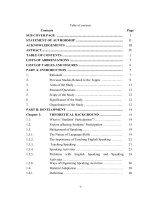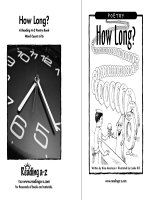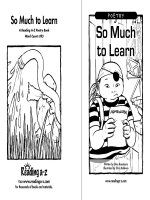Sách Tiếng Anh How to write an interview explorer junior library how to write
Bạn đang xem bản rút gọn của tài liệu. Xem và tải ngay bản đầy đủ của tài liệu tại đây (1.39 MB, 28 trang )
LA
A
Read all the Language Arts Explorer Junior writing titles:
how to write an interview
Writing is an important skill that you use almost every
day. You use it in school, with friends, at home—almost
anywhere! Whether you’re working on a school report
or journaling about your day, the Language Arts
Explorer Junior writing series has tips and tricks that will
start you on your way to becoming a writing expert!
LA
A
Minden and roth
GE
A
U
NG TS
R
ORER
L
P
X
E NIOR
JU
E
G
A
U
G
N TS
R
R
E
R
O
EXPLNIOR
JU
How to
Interview
ISBN 978-1-60279-996-7
9 781602 799967
LA_ExJr_cvr5.indd 5
7/29/10 12:34 PM
L
GUAGE
N
A RTS
A
EXPLORER
JUNIOR
Cherry Lake PubLishing • ann arbor, miChigan
Published in the United States of America by Cherry Lake Publishing
Ann Arbor, Michigan
www.cherrylakepublishing.com
Content Adviser: Jeannette Mancilla-Martinez, EdD, Assistant Professor of
Literacy, Language, and Culture, University of Illinois at Chicago
Design and Illustration: The Design Lab
Photo Credits: Page 4, ©iStockphoto.com/Maica; page 6, ©iStockphoto.
com/stuartbur; page 10, ©iofoto/Shutterstock, Inc.
Copyright ©2011 by Cherry Lake Publishing
All rights reserved. No part of this book may be reproduced or utilized in
any form or by any means without written permission from the publisher.
Library of Congress Cataloging-in-Publication Data
Minden, Cecilia.
How to write an interview/by Cecilia Minden and Kate Roth.
p. cm.—(Language arts explorer junior)
Includes bibliographical references and index.
ISBN-13: 978-1-60279-996-7 (lib. bdg.)
ISBN-10: 1-60279-996-2 (lib. bdg.)
1. Interviewing in journalism—Juvenile literature. I. Roth, Kate. II.
Title. III. Series.
PN4784.I6M45 2011
070.4'3—dc22
2010029824
Cherry Lake Publishing would like to acknowledge the work
of The Partnership for 21st Century Skills. Please visit
www.21stcenturyskills.org for more information.
Printed in the United States of America
Corporate Graphics Inc.
January 2011
CLSP08
C haPt er o ne
The Interview . . . . . . . . . . . . 4
C haPt er t wo
Do Your Research! . . . . . . . . 6
chapt er t h r e e
Write Great Questions . . . 10
C haPt er f o u r
Be a Good Listener . . . . . . . . .14
chapt er f i v e
Make Choices . . . . . . . . . . . . . .18
chapt er s i x
Final Touches . . . . . . . . . . . 20
Glossary . . . . . . . . . . . . . . . . . . . . . . . . 22
For More Information . . . . . . . . . . . . 23
Index . . . . . . . . . . . . . . . . . . . . . . . . . . 24
About the Authors . . . . . . . . . . . . . . . 24
C ha Pt er o n e
You can learn
a lot
about someone
by
asking questio
ns .
How can you learn about other people?
You can do an interview. You might discover
something new about someone you already
know!
An interview is a meeting. One person asks
another person questions. The answers can be
4
written up for other people to read. How do
you write an interview? First, you choose
someone to interview. Then you follow these
basic steps:
1. Decide what you already know.
2. Decide what you want to know.
3. Interview the person.
4. Use your notes to write up the interview.
For your first interview, pick someone you
know. Maybe there is a classmate you would
like to know better. In this book, we’ll create an
example interview with a new student.
Here’s what you’ll need to complete the
activities in this book:
• Notebook
• Pen
• Ruler
• Recorder
5
C ha Pt er t wo
Do some research before the interview. The
student in our example is from Toronto,
Canada. Learn about that city first. What you
learn may give you ideas for good questions.
Start your res
earch by
finding Toront
o on a map .
6
mes to
What co
ou
d when y
n
i
m
r
u
o
y
Canada?
t
u
o
b
a
k
thin
As you prepare, use a chart to keep track of
what you already know. This may lead you to
more questions. Let’s say you know that the
new student plays soccer. Does he play other
sports? You know he likes animals. Does he
have pets?
7
J
tivity
c
a
InSTRuCTIonS:
1 . use your ruler to draw a line down the center of
a page in your notebook . You should now have two
long boxes .
2 . Write “What I Know:” at the top of the box on
the left .
3 . In this space, write facts you know about the
person you will interview . Write what you learned
from any research here, too .
4 . Write “What I Want to Know:” at the top of the
box on the right .
5 . Think of what you want to learn from the
interview . Write these things in this box .
8
WHaT I KnoW:
WHaT I WanT T
o KnoW:
• His name is D
om
• He likes anima
ls.
inic.
• He is on the s
occer
team.
• He is from Tor
onto,
Canada.
• Hockey is a po
pular
sport in Canada.
• If he has pets
• What he liked
to do
in Toronto
• Did he play ho
ckey in
Toronto?
• What he miss
es about
living there
9
c ha pt er t h r e e
Writing good
questions is an
important par
t of getting
ready to inter
view someone .
Think of questions you will ask during the
interview. Start with questions that have a yes
or no answer. They are easier to answer. For
example, you can ask, “Do you like to play
soccer?” The person will answer “yes” or “no.”
10
You will also want to ask questions that will
give you more information. For example, the
question “Why is soccer your favorite sport?”
lets the person give an opinion. The person
may share his reasons for liking soccer.
It is important to have a list of questions
ready before the interview. Pay attention to the
speaker’s answers. They can help you think of
even more questions to ask.
r
cce
o
s
e
.
I lik use . .
a
bec
Try to
ask que
stions t
require
hat
someon
e
t
more th
o say
an “yes
” or “no
.”
11
tivity
c
a
InSTRuCTIonS:
1 . Look over the chart you made earlier . Your notes
will help you think of questions to ask .
2 . Write the questions on another sheet in your
notebook .
3 . Be sure to leave space under each question for
the person’s answers.
:
oW
WHaT I Kn
12
Dominic.
is
e
m
a
n
• His
imals.
n
a
s
e
k
li
e
• H
soccer
e
h
t
n
o
is
• He
team.
onto,
r
o
T
m
o
r
f
• He is
Canada.
a popular
is
y
e
k
c
o
H
•
nada.
sport in Ca
noW:
K
o
T
T
n
a
WHaT I W
s pets
• If he ha
ed to do
k
li
e
h
t
a
h
• W
in Toronto
ockey in
h
y
la
p
e
h
• Did
Toronto?
es about
s
is
m
e
h
t
a
• Wh
living there
QueSTIonS:
Q: When did you
move here?
a:
Q: I learned that
hockey is popular
in Canada.
Do you play?
a:
Q: What did you
like to do in Toron
to?
a:
Q: What do you m
iss about Toronto
?
a:
Q: Do you have a
ny pets? If so, wh
at kind?
a:
Q: Would you like
to say anything e
lse?
a:
13
C ha Pt er f o u r
Now it is time for the interview! It is a good
idea to use a recorder during the interview.
You can play the interview back later. It will
help you remember details. Ask the
interviewee for permission before recording
the interview.
a
od ide
o
g
a
r
It is
corde
e
r
a
to use
rview .
e
t
n
i
n
a
during
14
LA
A
GE
A
U
NG TS
R
RER
O
L
P
EX NIOR
JU
Intervi
ewing s
omeone
can be
a lot of
fun!
tivity
c
a
InSTRuCTIonS:
1 . Turn on the recorder if you are using one. Don’t
forget to turn it off after the interview .
2 . Ask the questions on your list . Give the speaker
time to answer each one .
(ConTInueD on pAGe 16)
15
JU
ac
tivity
(ConDuCTInG The InTeRvIeW ConTInueD)
3 . Listen carefully . Take notes on what you want
to remember about each answer . Your notes do
not have to be full sentences, but they should be
clear. Are you planning on using a person’s exact
words in part of your report? Be sure to write
down those words exactly as they were spoken .
4 . Look at the speaker
as you take notes .
for
u
o
y
k
5 . After the interview,
Than he time
t
thank the person for
taking with me!
k
taking the time to talk
to tal
with you .
16
QueSTIonS:
Q: When did you
move here?
a: 3 months ago
Q: I learned that
hockey is popular
in Canada.
Do you play?
a: Yes—one of m
y favorite sports
Q: What did you
like to do in Toron
to? This
a: Going to zoo
answer could
Q: What do you m
iss about Toronto
?
a: My friends
lead
you to ask, “W
hat is
your favorite
animal?”
Q: Do you have a
ny pets? If so, wh
at kind?
a: Yes—cat name
d Chip
Q: Would you like
to say anything e
lse?
a: Like it here. W
ill visit Toronto this
summer.
17
c ha pt er f i v e
LA
A
GE
A
U
NG TS
Read your notes. DecideRwhat to write in the
R
interview. You don’t haveXtoPLuse
OREeverything
E NIOR
from your notes. Stick withJU
the most interesting
points.
tivity
c
a
InSTRuCTIonS:
1 . Choose the information you want to use from your
notes . put this information into paragraphs .
2 . Write the interview on another page in your
notebook . Imagine you are writing the interview
for your classmates to read .
3 . Begin by giving the person’s name.
4 . Write a new paragraph for each topic .
18
an InTeRvIeW
WITH oaK eLeM
enTaRY ’S
neWeST STuDe
nT
There’s a new bo
y at our school. H
is name is
Dominic. He move
d here 3 months
ago from
Toronto, Canada.
Dominic plays soc
cer. It is one of h
is favorite
sports. He also lik
es playing hockey.
He liked visiting th
e zoo in Toronto. T
hat’s not
surprising becaus
e he loves animals
. He has a cat
named Chip.
Dominic likes it h
ere, but he misse
s his friends
in Toronto.
Say hi when you s
ee Dominic in the
halls. Let’s
all make him feel
welcome!
19
c hapt er f i v e
LA
A
Make your interview report
more
interesting by
E
G
A
U
adding quotes. When
quote someone, you
NGyou
S
T
R
must write exactly what the speaker
R said. Put
E
R
O
PL person’s
EXthe
R exact words.
quotation marks around
UNIO
J
tivity
c
a
InSTRuCTIonS:
1 . Read your interview report .
2 . Replay the interview if you used a recorder . Listen
for interesting quotes . Make sure you use the
person’s exact words.
3 . Add any quotes to your report using quotation
marks .
20
an InTeRvIeW
WITH oaK eLeM
enTaRY ’S
neWeST STuDe
nT
There’s a new bo
y at our school. H
is name is
Dominic. He move
d here 3 months
ago from
Toronto, Canada.
Dominic plays soc
cer. It is one of h
is favorite
sports. He also lik
es playing hockey.
He liked visiting th
e zoo in Toronto. T
hat’s not
surprising becaus
e he loves animals
. He has a cat
named Chip.
Dominic likes it h
ere, but he misse
s his friends
in Toronto. “It’s n
ot easy being the
new kid in class.
Making friends c
an be hard,” he s
ays.
Say hi when you s
ee Dominic in the
halls. Let’s
all make him feel
welcome!
After you finish writing, go over your work.
Make changes until everything is just right. Then
give the person you interviewed a copy of your
writing. Who will you interview next?
21
information (in-fur-MAY-shuhn) knowledge and facts
interview (IN-tur-vyoo) a meeting during which a person is asked
questions about herself or a subject
interviewee (in-tur-vyoo-EE) a person who is being asked questions
about herself or a subject
opinion (uh-PIN-yuhn) a person’s beliefs and ideas about somebody
or something
paragraphs (PAIR-uh-grafss) groups of sentences about certain ideas
or subjects
quotes (KWOHTSS) someone’s exact words that are copied
somewhere, such as in a piece of writing
recorder (rih-KOR-dur) a machine that copies sounds so they can be
listened to later
research (REE-surch) careful study of something to learn about it
topic (TOP-ik) the subject of a piece of writing
22
Books
Jarnow, Jill. Writing to Retell. New York: PowerKids Press, 2006.
Raczka, Bob. The Vermeer Interviews: Conversations with Seven Works
of Art. Minneapolis: Millbrook Press, 2009.
WeB sites
BBC—Listening—Asking Questions
www.bbc.co.uk/schools/ks3bitesize/english/speaking_listening/
listening/revise3.shtml
Look here to learn more about listening and asking questions.
scholastic—How to Conduct an interview
www2.scholastic.com/browse/article.jsp?id=3752516
Find more tips for conducting a great interview.
23









